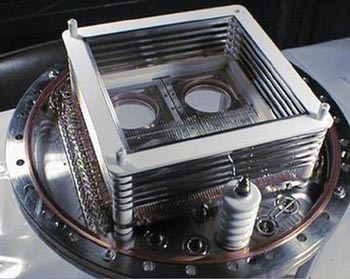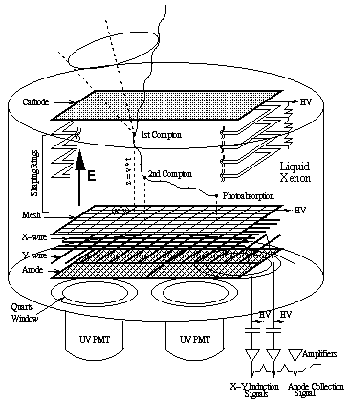
The gamma-ray detector of the LXeGRIT balloon payload is a Liquid Xenon Time Projection Chamber (LXeTPC), optimized for gamma-rays in the range of 0.3-10 MeV. Liquid xenon is an ideal material for gamma-ray detection due to its high density (3 g/cm3) and high atomic number (Z=54). Above 250 keV, gamma-rays in LXe lose their energy mostly through Compton scattering. The ionization and excitation of xenon atoms which result from these interactions produce a large number of electron-ion pairs (64,000 e-/ MeV) and a similar number of scintillation photons. In the LXeGRIT TPC the scintilation light is read-out using four UV sensitive photomultiplier tubes (PMTs) coupled to the interaction volume, while the ionization electrons are drifted via a uniform electric field through a pair of mutually orthogonal sets of parallel wire sense electrodes, and collected on an anode plane. The scintillation light signal is fast (less then 5 ns) and thus provides an ideal marker of the time of origin of a gamma-ray interaction. From the measured electron drift time, referred to this time origin, and the known drift velocity, the Z-coordinate of the interaction point, along the drift direction, is inferred. The other two spatial coordinates are inferred from the charge signals induced on the sensing electrodes, while the energy of the event is determined by the charge collected at the anode. Thus the LXe-TPC measures both the energy and the three-dimensional spatial position of every ionizing event occuring within its active volume. For a multiple Compton interaction, the anode signal has a characteristic multistep shape, which provides a clear visualization of the event topology. Each step is proportinoal to the energy deposited at the respective interaction site, and the sum of all steps is proportional to the energy of the initial gamma-ray, assuming all the energy is eventually deposited in the liquid. The time difference between steps gives the seperation between sites, in Z-direction.
From the knowledge of the spatial coordinates of all interaction points and the energy transferred to each Compton electron, the arrival direction of the incident gamma-ray and its energy can be reconstructed. The arrival direction is confined to a cone of half opening angle equal to the scattering angle, and with its axis along the scattered gamma-ray direction. The location of the source is then found from the intersection of cones from a collection of individual events. The LXeTPC prototype developed for LXeGRIT is shown in the image above and its principle of opertaion shown in the figure below.
